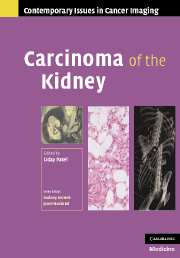Book contents
- Frontmatter
- Contents
- Contributors
- Series foreword
- Preface to Carcinoma of the Kidney
- 1 Renal cell cancer: overview and immunochemotherapy
- 2 Pathology of adult renal parenchymal cancers
- 3 Familial and inherited renal cancers
- 4 Radiological diagnosis of renal cancer
- 5 Staging of renal cancer
- 6 The case for biopsy in the modern management of renal cancer
- 7 Imaging characteristics of unusual renal cancers
- 8 Surgery for renal cancer: current status
- 9 Ablation of renal cancer
- 10 Post-treatment surveillance of renal cancer
- 11 Imaging for nephron-sparing procedures
- Index
- Plate Section
- References
7 - Imaging characteristics of unusual renal cancers
Published online by Cambridge University Press: 08 August 2009
- Frontmatter
- Contents
- Contributors
- Series foreword
- Preface to Carcinoma of the Kidney
- 1 Renal cell cancer: overview and immunochemotherapy
- 2 Pathology of adult renal parenchymal cancers
- 3 Familial and inherited renal cancers
- 4 Radiological diagnosis of renal cancer
- 5 Staging of renal cancer
- 6 The case for biopsy in the modern management of renal cancer
- 7 Imaging characteristics of unusual renal cancers
- 8 Surgery for renal cancer: current status
- 9 Ablation of renal cancer
- 10 Post-treatment surveillance of renal cancer
- 11 Imaging for nephron-sparing procedures
- Index
- Plate Section
- References
Summary
Introduction
A wide variety of malignant neoplasms have been described in the kidney, but 90% of primary renal cancers are classified as renal cell carcinomas (RCC). Transitional cell carcinomas (TCC) account for about 5%–8% of renal cancers; and nephroblastomas, sarcomas, lymphoma, and metastases commonly from breast, bronchus, and malignant melanoma account for a further 5% of renal cancers.
The increased use of ever-evolving cross-sectional imaging has resulted in early and incidental diagnosis of renal cancers. Up to 40% of renal tumors are now incidentally detected and at an earlier stage. For example, 82% of incidentally detected tumors are below stage pT3 compared with only 35% of symptomatic tumors and the disease-free and 5-year survival time is significantly better in lower stage tumors. These favorable prognostic features allow recent developments in localized lesion therapies such as ablation techniques, embolization and nephron-sparing surgery to be offered as practical treatment options to conventional nephrectomy. However, histological subtypes with a poor prognosis such as collecting duct carcinomas, sarcomas and TCCs are not suitable for these nephron-sparing treatment options. Lymphoma and metastatic lesions require systemic chemotherapy. Furthermore, although localized treatment may be offered to patients with locally advanced renal cancer and intractable hematuria in a palliative setting, recent developments in targeted chemotherapy may alter the approach to these patients (as discussed in Chapter 1). It is also important to know the histological subtype of the renal cancer prior to embarking on localized treatment options.
- Type
- Chapter
- Information
- Carcinoma of the Kidney , pp. 126 - 154Publisher: Cambridge University PressPrint publication year: 2007



